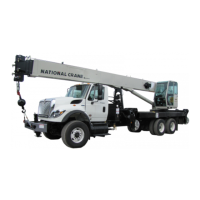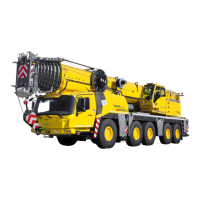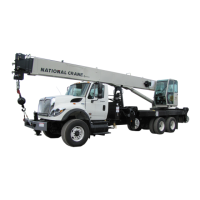Manitowoc Published 12-05-17, Control # 035-23 1-21
18000 SERIVCE/MAINTENANCE MANUAL INTRODUCTION
Each system pump has a gerotor type gear charge pump
that is internally mounted on the end of each pump system
driveshaft. System charge pump draws fluid directly from the
tank suction manifold and delivers it to closed-loop system at
a charge pressure of approximately 350 psi (24 bar). Charge
pressure depends on engine load/speed, pressure relief
valve settings, and hydraulic system efficiency.
When a system control handle is moved, a node controller
sends a variable zero to 24 volt output to pump EDC as
required for handle command direction. Pump EDC tilts
swashplate to stroke pump in the command direction. Pump
pistons move within cylinder block as the block rotates. The
longer stroke of each piston draws in return fluid from system
motor. As the stroke shortens, hydraulic fluid is pushed out of
pump piston cylinders into hydraulic piping to the motor.
Pressurized hydraulic fluid from the pump turns the motor in
the command direction.
Hydraulic fluid displaced by motor returns through piping to
inlet side of system pump. Swashplate tilt angle determines
volume of fluid that can be pumped to the motor. Increasing
swashplate tilt angle increases piston stroke length, allowing
more fluid to be pumped to the motor. Motor servos in drum
and travel systems allow low and high speed operation.
Hoist and swing system that have two pumps driving two
motors have a pressure equalizing lines between pump legs
A and B.
Each pump has two multifunction valves that consist of
system relief valve and charge flow make-up check valve.
Pump system multifunction valves control maximum system
pressure and protect each pump system from damage by
limiting pressure spikes in each operating direction. When
preset loop system pressure is reached, multifunction valves
limit system pressure by de-stroking pump or transferring
fluid from high-pressure side to low-pressure side. Maximum
pressure setting of multifunction valves for each pump is
listed in Table 1-1
. Limits should not be reached unless there
is a failure in the system.
Table 1-1 Multifunction Valve Pressure Limit Settings
Charge Pressure
Charge pressure in each closed-loop system is preset at
approximately 350 psi (24 bar) with a relief valve in charge
pump. Charge pressure must be at preset value as lower
pressures can cause a slowing or stopping of operation. If
the charge pressure is set too high, the hydraulic system
could be damaged. When a system control handle is in
neutral the digital display indicates system charge pressure.
If any charge pressure system drops, the system brake
begins to apply at approximately 200 psi (14 bar). Main
system pumps de-stroke when charge pressure drops to
minimum pressure.
Hydraulic Motors
See Sauer-Sundstrand Series 90 Service Manual for a
description of a hydraulic motor.
Main hoist 1 (Drum 1), main hoist 2 (Drum 2), boom hoist
(Drum 4), left crawler, and right crawler systems have two
hydraulic motors.
Variable displacement low torque/high speed, bent axis
piston hydraulic motors are used in the travel, boom hoist,
and load drum systems. The swing system motor is a fixed
displacement, low torque/high speed, bent axis piston
hydraulic motor. Each motor contains a cylinder block,
pistons, output shaft, and internal flushing valve. Boom hoist
and load drums motors have a PCP (Pressure Control Pilot)
valve that controls output speed/torque of the motor.
Motor cylinder block axis is tilted at an angle to output shaft
with pistons fitted axially around its axis. The internal end of
output shaft has a large flange face similar to pump
swashplate. The motor piston ends are connected to output
flange face and do not ride around the axis of rotating flange
face like the pump pistons.
Hydraulic fluid from pump enters inlet side of motor and
places a force against pistons. The retained piston ends
place a thrust against output flange with a rotational torque
that turns output shaft. This also rotates the cylinder block on
bent axis, while tilt angle to flange face moves the pistons as
they rotate. Hydraulic fluid displaced by the motor pistons,
exits outlet side of motor and returns to inlet side of system
pump through piping.
SYSTEM FUNCTION PRESSURE (BAR)
Load Drums
(1, 2, and 3)
Hoist 6,090 (420)
Lower 3,770 (260)
Boom Hoist
(Drum 4)
Up 6,090 (420)
Down 3,770 (260)
Mast Hoist
(Drum 5)
Up 6,090 (420)
Down 3,770 (260)
Luffing Jib Hoist
(Drum 6)
Up 6,090 (420)
Down 3,770 (260)
Swing
Left 6,090 (420)
Right 6,090 (420)
Travel
Forward 6,090 (420)
Reverse 6,090 (420)
Cooler Fan
(Tier 4)
Port A 3,330 (230)
Port B 3,330 (230)
SYSTEM FUNCTION PRESSURE (BAR)
